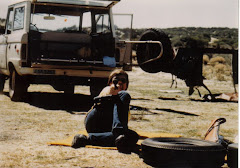
I grew up in Grand Forks. Actually, I went to 1st and 2nd grades in a little town 13 miles west of Grand Forks in which my grandfather owned a general store and a fleet of grain trucks. In his teens, Dad drove one of the trucks to bring farmers' wheat to the railroad. After high school, my dad worked for the Great Northern Railroad in those years, and took jobs in many towns in the northeast of North Dakota. I was born in Langdon, a little town about 8 miles from the Canada border.
Before I started school, Dad had managed to get a more stable position with the railroad back in Emerado. That led to a better job in Grand Forks as I was entering fifth grade.
During my childhood I experienced two of these spring floods. The first was in, I think, 1949. Beyond the river bank, the land is very nearly flat. Once the water rises beyond the levees, it's free to sheet across miles of flat farmland. In '49, I recall that the water in Emerado was 2-3-feet deep.
You couldn't drive a car. Most didn't try to drive trucks. Basements filled with water, but the first floor of houses were often left dry, very slightly above the level of the water. The hardwood floor of my grandfather's store was soaked, causing it to buckle and bulge. Everyone waded around in the streets for a few days, but after a few days or weeks of fixin' and cleanin', things gradually returned to normal.
The second flood, after we moved to Grand Forks, was similar, maynbe not so bad--except now we were closer to it. Aside from a basement full of water, we escaped fairly unscathed. The only thing I remember clearly was the National Guard working on the levees and their amphib vehicles the only vehicles in the streets.
I was a mite young in those days, but most able-bodied individuals would involve themselves in sandbagging the levees, patrolling them, sandbagging around their dwellings and businesses and other work to save their property from the high water.
The river swells every spring there, mostly due to the snow melt. Factors affecting the degree of flooding include the amount of snow on the ground and the suddenness of the spring thaw and, of course, the severity of spring rains.
The 1997 flood was apparently particularly severe, since much of the effort was in vain and there were many dwellings and business buildings lost. I wasn't there, but I'm sure that the heroic efforts of the area residents at least equaled and probably surpassed those of other years.
We're not getting so much news from Grand Forks this spring, since the more urgent danger seems to be 80-miles south, in Fargo. We see a lot of video of local residents working very hard filling and placing sandbags atop the levees there.
Pridefully, I have to say that Dakotans live tougher lives than do most of us, and are aware of the special problems that exist in that part of the country. There's a willingness to work together to overcome these problems. Part of it is a hardy individualism coupled with the knowledge that a benevolent cooperation will overcome difficulties that are just too much to handle alone.
The National Guard is there, as usual--probably in smaller numbers since the feds have commandeered many of them to do the regular Army's job in Afghanistan and Iraq--and using its heavy equipment to its best advantage.
I'm kind of proud, in a way, to have grown up in those surroundings, because I know I'd be there helping if I were still living in that part of the country. Most of us were brought up aware of our situation, to be self reliant with a sense of benevolence for our neighbors.
I've heard just about enough of California whining.
Warm regards,
Col. Hogan
Stalag California










